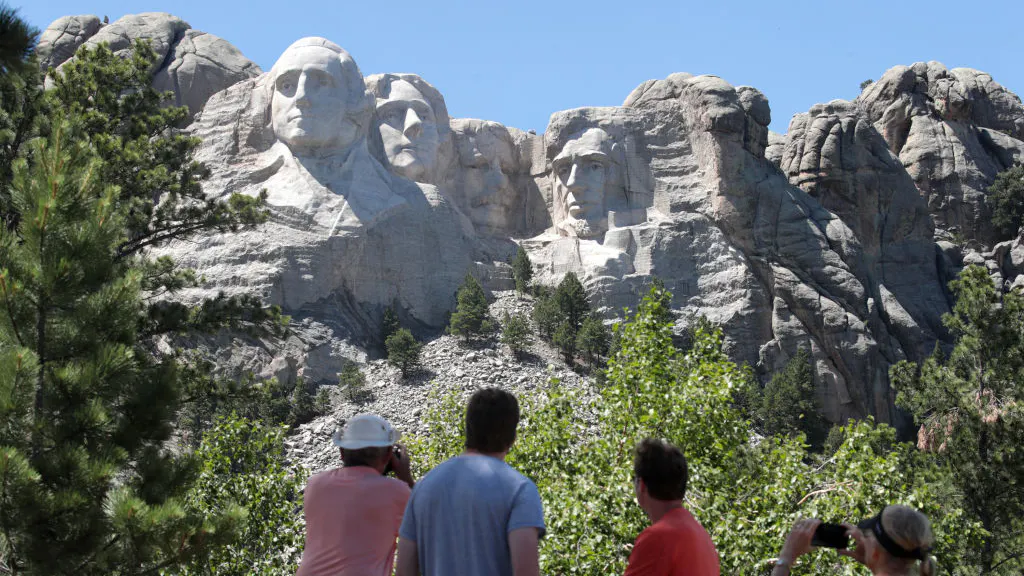The New York Times published an article and a promotional tweet on Wednesday laying out the case against one of America’s most iconic monuments, Mount Rushmore, a move that came within a couple of days of a quickly deleted tweet by the Democratic Party expressing a similar sentiment.
In a since-deleted tweet Monday night, the Democratic Party described President Trump’s upcoming Independence Day celebrations at the famous monument as “glorifying white supremacy at Mount Rushmore — a region once sacred to tribal communities.”
“Trump has disrespected Native communities time and again,” the party tweeted. “He’s attempted to limit their voting rights and blocked critical pandemic relief. Now he’s holding a rally glorifying white supremacy at Mount Rushmore — a region once sacred to tribal communities.”
The Democrats think Mt Rushmore is a display of white supremacy.
There’s no saving this country if Biden gets elected.
(They deleted their tweet.) pic.twitter.com/hm6r11IjRR
— Jason Rantz on KTTH Radio (@jasonrantz) June 30, 2020
On Wednesday, The New York Times published a piece effectively expanding on the Democrats’ swipe at Mount Rushmore.
In a tweet summarizing some of the article’s key points, the Times wrote: “Mount Rushmore was built on land that belonged to the Lakota tribe and sculpted by a man who had strong bonds with the Ku Klux Klan. It features the faces of 2 U.S. presidents who were slaveholders.”
Mount Rushmore was built on land that belonged to the Lakota tribe and sculpted by a man who had strong bonds with the Ku Klux Klan. It features the faces of 2 U.S. presidents who were slaveholders.https://t.co/pHmJScnYbb
— The New York Times (@nytimes) July 1, 2020
The article, titled “How Mount Rushmore Became Mount Rushmore,” details how “the South Dakota landmark has drawn criticism over the land it occupies, the main sculptor behind it and the legacies of the men it memorializes.”
A few excerpts on the Times’ report on the “big, big piece of Americana” [formatting adjusted]:
Before he was recruited to create Mount Rushmore, Mr. [Gutzom] Borglum had been involved with another project: an enormous bas-relief at Stone Mountain in Georgia that memorialized Confederate leaders. It was eventually completed without him, but Mr. Borglum formed strong bonds with leaders of the Ku Klux Klan and participated in their meetings, in part to secure funding for the Stone Mountain project. He also espoused white supremacist and anti-Semitic ideas, according to excerpts from his letters included in “Great White Fathers,” a book by the writer John Taliaferro about the history of Mount Rushmore. …
Mount Rushmore is built on land that had belonged to the Lakota tribe. “Wherever you go to connect to God, that’s what the Black Hills are to the Lakota,” said Nick Tilsen, a member of the Oglala Lakota tribe and the president of NDN Collective, an Indigenous activist group. Prospectors seized the land during a gold rush in the 1870s, violating the Fort Laramie treaty of 1868, which recognized the Black Hills as belonging to Native Americans, Mr. Tilsen said in an interview.
Like the Democratic Party’s rapidly pulled tweet, the Times’ post promoting its Mount Rushmore piece was met with intense criticism online.
Below are just a few examples of the flood of overwhelmingly negative responses to the Times’ apparent push to “cancel” the beloved monument, including many pointing out that the Times has its own “problematic” past:
In 1851, @nytimes founding editor Henry Jarvis Raymond published an editorial in which he supported a slaveowner’s legal right to recover his escaped slaves.
Will you guys also be canceling yourselves? https://t.co/kaK6NtVZPz
— PragerU (@prageru) July 1, 2020
The @nytimes, a #formernewspaper, was built on land that belonged to the Canarsee tribe and covered up both the Holocaust and the Communist starvation of millions. https://t.co/pF94XtK8xj
— Andrew Klavan (@andrewklavan) July 1, 2020
And the @nytimes headquarters is built on Lenape land which was stolen.
Until the @nytimes gives up their building to their descendants, anyone working for them is clearly involved in white supremacy. https://t.co/faOnHGx6y0 https://t.co/DA8lOdSoQl
— Pradheep J. Shanker, M.D. (@neoavatara) July 1, 2020
This building is built on land basically stolen for $24 from the Delaware Indians. You implode this temple of America-hating assholes I’ll give you the mountain. pic.twitter.com/5tib3GLrJx
— Jon Nicosia (@NewsPolitics) July 1, 2020
https://twitter.com/HOLYSMKES/status/1278399811746533376?ref_src=twsrc%5Etfw%7Ctwcamp%5Etweetembed%7Ctwterm%5E1278399811746533376%7Ctwgr%5E&ref_url=https%3A%2F%2Ftwitchy.com%2Fdougp-3137%2F2020%2F07%2F01%2Fyall-have-lost-your-minds-new-york-times-gets-tossed-in-the-shredder-after-reminding-everybody-why-mt-rushmore-is-problematic%2F
https://twitter.com/BealesHateChild/status/1278396671282601986
The Daily Wire, headed by bestselling author and popular podcast host Ben Shapiro, is a leading provider of conservative news, cutting through the mainstream media’s rhetoric to provide readers with the most important, relevant, and engaging stories of the day. Get inside access to The Daily Wire by becoming a member.

.png)
.png)

